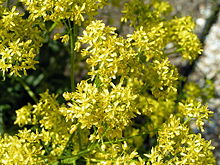Isatis tinctoria
| Isatis tinctoria | |
|---|---|
 |
|
| Woad flowers | |
| Scientific classification | |
| Kingdom: | Plantae |
| (unranked): | Angiosperms |
| (unranked): | Eudicots |
| (unranked): | Rosids |
| Order: | Brassicales |
| Family: | Brassicaceae |
| Genus: | Isatis |
| Species: | I. tinctoria |
| Binomial name | |
|
Isatis tinctoria L. |
|
| Synonyms | |
|
Isatis indigotica Fortune |
|
Isatis indigotica Fortune
Isatis tinctoria, also called woad (/ˈwoʊd/), dyer's woad, or glastum, is a flowering plant in the family Brassicaceae. It is occasionally known as Asp of Jerusalem. Woad is also the name of a blue dye produced from the leaves of the plant.
Woad is native to the steppe and desert zones of the Caucasus, Central Asia to eastern Siberia and Western Asia (per Hegi) but is now also found in southeastern and Central Europe and western North America. Long important as a source from which is obtained a blue dye, indigo, it has been cultivated throughout Europe, especially in Western and southern Europe, since ancient times. In medieval times there were important woad-growing regions in England, Germany and France. Towns such as Toulouse became prosperous from the woad trade. Woad was eventually replaced by the stronger Indigofera tinctoria and, in the early 20th century, both woad and Indigofera tinctoria were replaced by synthetic indigos.
Used in traditional Chinese medicine for centuries, woad is now being studied for use in the treatment of cancer. There has also been some revival of the use of woad for craft purposes.
The first archaeological finds of woad seeds date to the Neolithic. The seeds have been found in the French cave of l'Audoste, Bouches-du-Rhône, France. Impressions of the seeds of Färberwaid (Isatis tinctoria L.) or German indigo, of the plant family Brassicaceae, have been found on pottery in the Iron Age settlement of the Heuneburg, Germany. Seed and pod fragments have also been found in Iron Age pit at Dragonby, South Humberside, United Kingdom. The Hallstatt burials of the Hochdorf Chieftain's Grave and Hohmichele contained textiles dyed with woad dye.
...
Wikipedia
